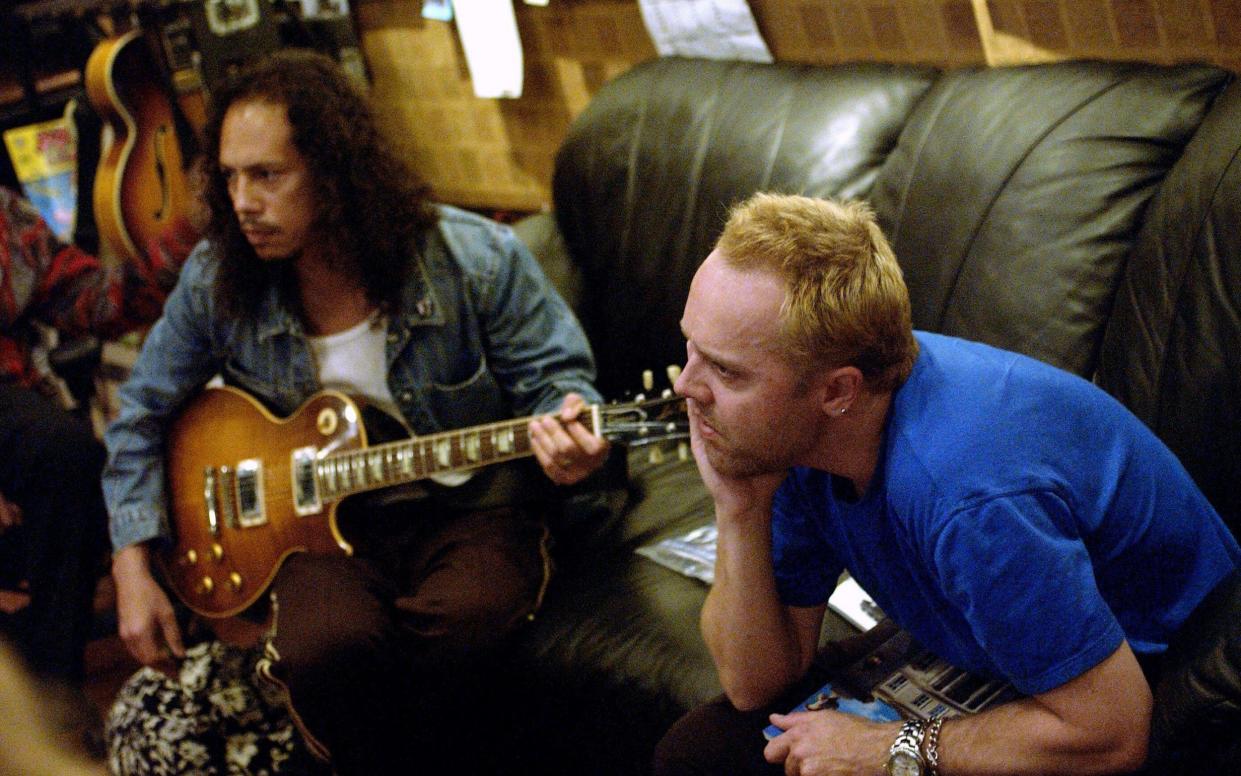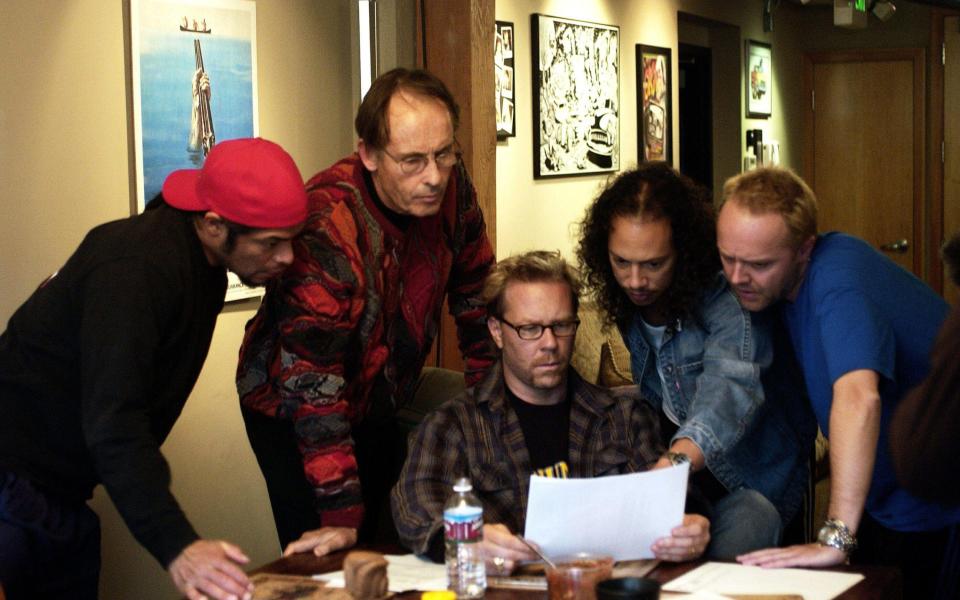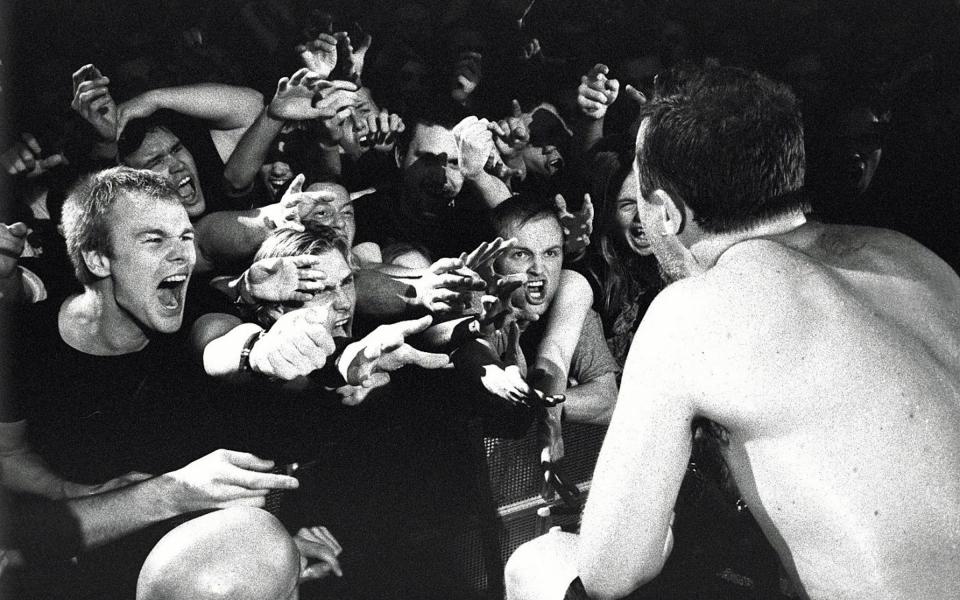‘I don’t wanna see Metallica going to f----- therapy’: inside the film that changed rock

- Oops!Something went wrong.Please try again later.
- Oops!Something went wrong.Please try again later.
- Oops!Something went wrong.Please try again later.
- Oops!Something went wrong.Please try again later.
- Oops!Something went wrong.Please try again later.
In March 2003 I was summoned to Northern California for an exclusive interview with Metallica. At that time it had been more than two years since the world’s highest-selling metal band had faced the press, for a Playboy article in which the tensions and fissures that were about to threaten their existence were already starting to show. In the intervening months, the task of completing a new album that was by now comically overdue had been further complicated by personal strife and an eruption of volcanic acrimony.
While nervously pacing the corridors of the band’s vast “HQ” in San Rafael, I was approached by a man who introduced himself as Joe Berlinger. It was explained to me that for the past two years, he and co-director Bruce Sinofsky had been filming the band for a project whose final form was as yet undecided. It might be a TV series in the style of then-popular The Osbournes, he said. Then, in a stage whisper, I was told that in an ideal world, the footage would become a feature film. I was asked if I would consent to a three-man crew shooting my interviews. “A feature film, eh?” I said, eyebrows raised, voice ascending through the octaves. “And will I be in it?” Berlinger reckoned so, yes.
This week that very film celebrates the 20th anniversary of its first public viewing, at the Sundance Film Festival in Park City, Utah. But despite a running time of more than two hours, not one frame of Metallica: Some Kind Of Monster is graced by my presence. Upon reflection, probably it was unwise of me to spend every waking second of every day telling every person I knew, and a far from discountable number of people that I didn’t know, that I would be playing a pivotal role in a forthcoming production about the group’s tortured revivification.
It is to Metallica’s great credit that despite being required to pick up the tab on their foray into motion pictures – not least, an outlay of $4.3million to acquire the rights from their then record company, Elektra – the band duly ceded full editorial control to Berlinger and Sinofsky. Over the course of a 715-day shoot, the co-directors amassed 1,602 hours of footage as well as seven miles of DAT tape. In total, 428 people posed for photographs while signing release forms permitting the use of their likeness on film. I suppose I can at least take comfort in not being the only aspirant movie star left stranded on the cutting room floor.
That Some Kind Of Monster was able to tell its story with a skill that made my own article seem like a speculative stab in the dark piled yet more ignominy onto my bruised ego. In truth, though, by the time Metallica faced the press to talk about St Anger, the album they had toiled for years to complete, the band had become salesmen for their new LP. Sure, they described their difficulties and delays in some detail, but the point they wished to make was that things were better now. Seeing as the default setting of the music press is to accentuate the positive, this was good enough for most.
Flying out to San Francisco, I knew that the band had sailed their listing ship for two years without a bass player, following the departure in 2001 of Jason Newsted. I knew that singer and rhythm guitarist James Hetfield had entered rehab. I had the strong sense that the famously complicated relationship between drummer Lars Ulrich (whose vision and drive, in the studio and beyond, had lit the path to world domination) and Hetfield (the man responsible for many of the riffs that formed the spine of Metallica’s songs) was presently in the doldrums. Doubtless, I was correct in believing I had the bare bones of the feature I hoped to write. But I barely knew the half of it.
Turns out that film was the medium required to tell the unexpurgated story of Metallica’s descent into collective madness. It showed their dysfunction unflinchingly, with piercing clarity. With inter-band relationships at their lowest ebb, Ulrich and lead guitarist Kirk Hammett’s willingness to allow the cameras to continue rolling while James Hetfield retreated to rehab for months on end allowed their vast audience to see just how close to extinction this apparently indomitable union actually came. Twenty years later, the question remains: how did it come to this?
How could it be that a band that had revolutionised the landscape of heavy music more than any other suddenly required the help of Phil Towle, a kindly-mannered performance enhancement coach hired at a cost of $50,000 per month, in order that its members could communicate as adults? “I ask the question, ‘What do Metallica need today, and how can I help them achieve what it is they need today?’” Towle told me, in 2016. “How can I help the band today in a way that will mean that by tomorrow some progress has been made? In its complexity the situation with Metallica was unlike anything I’d ever seen, before or since. And I don’t expect to see anything like it again.”

It was bad alright. “I’ve been in Metallica since I was 19 years old, which can be a very unusual environment for someone with my personality to be in,” Hetfield told me on my trip to the band’s “HQ”. “It’s a very intense environment. It’s easy to find yourself not knowing how to live your life outside of that environment, which is what happened to me. I didn’t know anything about life. I didn’t know that I could live my life in a different way to how it was in the band since I was 19, which was very excessive and very intense.”
Given that my own interview with James Hetfield was conducted in a room in which cartoon images of racing cars and their drivers had been painted on the walls, this state of arrested development was no surprise. The selfishness of it all, however, took me aback. Hetfield did whatever he wanted, whenever he wanted, and with whomever he desired. Something had to give. His decision to prioritise a hunting trip to Siberia (at which vodka was part of the breakfast menu) over a party on his second son’s first birthday saw him ejected from the family home. The catalyst for change had at last arrived.
“My wife finally told me, ‘Hey! I’m not one of your yes-men on the road – get the f--k out!’” he recalled. In rehab, he learned the importance of priorities. “Truly,” he said, [I] had to believe that I would survive without Metallica and that my health and well-being, and my family, was most important… basically, I knew that [the band] was my passion but I wasn’t going to allow it to still rule me in my mind and my reality. It took me a while to get to that point and I couldn’t come back until I had reached [it].”

But if the plight of a rock star derailed by personal habits is by now a well-thumbed story, the ardour of repairing a band’s engine is anything but. Upon at last returning to the fold, Hetfield insisted that the band work for only four hours each day so that he could spend more time at home. Okay, fine. But a subsequent demand that the group’s other members agree to not listen, even, to the results of their afternoon’s labours in his absence caused mayhem. At times, Some Kind Of Monster asks the viewer to choose between Team Ulrich and Team Hetfield. Certainly, the film is at its most compelling when examining the limits of the drummer’s tolerance for working practices he regards – rightly, I think – as being detrimental to the band and their creativity.
“I don’t understand who you are,” Ulrich tells Hetfield in the film’s pivotal scene. “All these rules and s--t, man. This is a f--king rock’n’roll band. I don’t want f--king rules… I don’t understand the [recovery] programme. I don’t understand all of this stuff.” The drummer then utters a sentence of such quiet devastation that it barely ripples the waters. “I realise now that I barely knew you before,” he says.
Really, it is no surprise that the group’s members were at last crushed by the weight of their own creation. In the 1980s, Metallica’s marriage of street-level thuggery and musical precocity attracted an army of swivel-eyed adherents who became foot-soldiers in a civil war against the dismal forces of hair and pop metal. When at last they went over-ground with an eponymous LP – known to all as “The Black Album” – that has to date sold more than 36 million copies, they did so with an authority that made the mainstream forever heavier and darker. T-shirts emblazoned with the audacious yet justified slogan “Birth School Metallica Death” spoke of their status as Gods.

But if their music was the work of pioneers, so too was Some Kind Of Monster. Ten years after the suicide of Kurt Cobain proved that happiness is not always index-linked to commercial success, Metallica allowed Joel Berlinger and Bruce Sinofsky to tell a story of a band whose successful quest for world domination had driven them insane. Some Kind Of Monster deserves credit for being the first real-time document of a group in the throes of collective and individual mental illness. It is the first word in a conversation between musicians that has today become commonplace.
“[James Hetfield] became the poster boy for mental health,” Phil Towle told me. “You have to remember that this was a time when people didn’t admit to undertaking this kind of intensive therapy. There was rehab, sure, where people went to give up drinking or drugs, but that was kind of all that was admitted to. James went to rehab to learn how to become a different person. A kinder person, a more gentle person… He showed people, ‘Hey, if I can admit to these things and seek help for them, then why can’t you?’”
Inevitably, not everyone in the none-more-bulletproof world of metal regarded the band’s decision to cast light into dark crevices as an honourable act. “I used to admire Metallica [but] I don’t wanna see them going to f--king therapy,” said Kerry King, the guitarist with Slayer. “I won’t watch that movie because I don’t want to think of them like that. I wanna think of [songs such as] f--king Battery and Damage Inc. and Ride The Lightning. I don’t wanna see these fragile f--king old men that can’t have a cocktail anymore because they’re afraid of what they’ll become. F--k that.”
Overwhelmingly, though, the movie was a ground-breaking success. In its ability to capture the attention and respect of the kinds of people who not only didn’t like Metallica – or who at least thought they didn’t – but who also suspected that metal itself was a worthless subculture, Some Kind Of Monster reaped rewards that had otherwise proved elusive. Overnight, the film changed the perception of its subjects in the eyes of strangers. The truth that the band represented something more than cheap entertainment was at last accepted by those who had previously considered Metallica, if they had considered them at all, only with condescension.
Six months before the movie’s release, in the summer of 2003, I was dispatched to Dallas to report on whether or not the band’s still fragile infrastructure could withstand the pressures of the road. So that James Hetfield might learn to function in an environment that had caused him no end of grief, each week on tour in North America, Metallica played three consecutive stadium concerts before flying home aboard a private jet for four days’ rest. Twenty-one years later, the balancing act continues to hold. Today, the band rests every two or three weeks when on tour.
At the Texas Stadium, minutes before taking to the stage, I watched Metallica start their engines playing Battery in a locker room belonging to the Dallas Cowboys. Despite an agonising rebirth, the fury remained. Come the end of the night, James Hetfield was at home once more in the suburbs of San Francisco.

